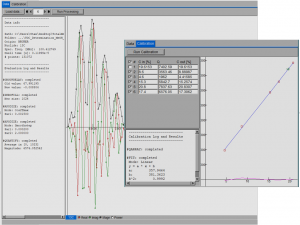Quantitative NMR analysis of chemical elements with a calibration support for assays by either low-field or high-field NMR. Discrimination modes: none (plain total), solid/liquid, aromatic/aliphatic (where applicable), isotopic.


Quantitative NMR analysis of chemical elements with a calibration support for assays by either low-field or high-field NMR. Discrimination modes: none (plain total), solid/liquid, aromatic/aliphatic (where applicable), isotopic.
TotalXMR is a Windows software Utility that loads time-domain NMR data (FID’s) from Bruker or other OEM and offers the User a set of processing and calibration tools needed to assess the total content of the observed nuclides in a sample.
Theoretically, since NMR is a quantitative method, and since the initial intensity of the FID is proportional to the number of the measured nuclides in the sample volume, all an assay of their amount should take is a measurement of the FID magnitude just after the excitation pulse.
However, we know that in practice such a quantitation is not so simple. In general, the signal value just after the excitation pulse is not available, covered up by artefacts such as group delay, dead time and probe ringing, while at later times the FID becomes affected by the distribution of chemical shifts and coupling constants within the sample spectrum – which means by the chemical composition of the sample.
Moreover, the absolute FID magnitude is rather undefined due to unknown absolute RF gain settings and a continuous distribution of responsivity through the sample volume. It therefore requires a reliable calibration procedure, but proposed instrumental solutions – such as ERETIC – tend to be very inaccurate.
TotalXMR gives the User the possibility to remove or mitigate all these effects (this is controlled by a small number of parameters). The problem of estimating the FID magnitudes is solved elegantly by empirical calibration on two or more reference samples for which TotalXMR provides an elegant and practical data evaluation support.
Since only the signal magnitudes at very short times after the excitation pulse are needed, potentially any kind of NMR instrument can be used: low-resolution, high resolution, low field, high field, it should not matter, except for sensitivity which, of course, grows sharply with the field strength. Measurements are normally carried out without any decoupling. When needed, one can boost sensitivity by scans accumulation, possibly combined with the addition of a standard amount of a paramagnetic relaxation agent to reduce the delays between scans.
We have so far tested the method on high-field Bruker data and nuclides 1H, 13C, 29Si. For other instruments and/or nuclides, Extra Byte will be glad to provide an extensive, free-of-charge consulting, including the adaptation of TotalXMR to your experimental data formats (purchasing a license, you purchase also a year-long consulting and collaboration service).
Note: Adjusting the parameters of the particular apodization function(s) used in TotalXMR, one can introduce the capability to combine the quantitative assays with a discrimination between the various states/environments of the assayed nuclides. Typical examples are solid/liquid phases, aprotic/protonated 13C or 29Si, and aromatic/aliphatic 1H or 13C. Even more discriminations (for example in terms of T1 or T2) can be achieved by means of particular acquisition sequences.
Please contact us if you wish to try the TotalXMR utility to solve your specific total quantitation problem.